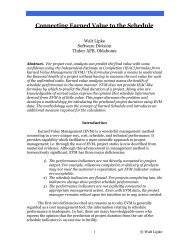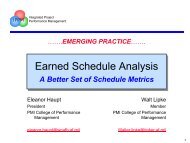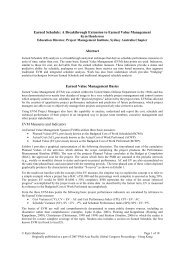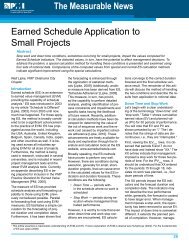EVM = EVM: Earned Value Management Yields ... - Earned Schedule
EVM = EVM: Earned Value Management Yields ... - Earned Schedule
EVM = EVM: Earned Value Management Yields ... - Earned Schedule
You also want an ePaper? Increase the reach of your titles
YUMPU automatically turns print PDFs into web optimized ePapers that Google loves.
<strong>EVM</strong> = <strong>EVM</strong>: <strong>Earned</strong> <strong>Value</strong><strong>Management</strong> <strong>Yields</strong> Early Visibility &<strong>Management</strong> Opportunitiespresented byHarry SparrowforTHE SOCIETY OF COST ESTIMATING & ANALYSIS2004 NATIONAL CONFERENCE & TRAINING WORKSHOPJune 15-18, 2004Los Angeles, California829 Chiles Avenue St. Helena, CA 94574707-967-0420 hsparrow@pmassoc.com
<strong>EVM</strong> Isn’t Just EV◆ It is integrated project management◆ Specifically, it is predicated on thedevelopment of a baseline◆ Integrates the technical (scope), cost, andschedule elements of the plan◆ Presumes the maintenance of this baselineover the life of the projectCopyright © 2004 • All Rights ReservedPerformance <strong>Management</strong> Associates, Inc.SCEA04 <strong>EVM</strong> = <strong>EVM</strong>2
<strong>Earned</strong> <strong>Value</strong> <strong>Management</strong> (<strong>EVM</strong>):Integrated Project <strong>Management</strong>Copyright © 2004 • All Rights ReservedPerformance <strong>Management</strong> Associates, Inc.SCEA04 <strong>EVM</strong> = <strong>EVM</strong>3
<strong>EVM</strong>: A Vision*The quality of a management system isdetermined not by the absence of defects, butby the presence of managementvalueGary Christle, The Cost/<strong>Schedule</strong> Control Systems Criteria(C/SCSC) and <strong>Earned</strong> <strong>Value</strong> <strong>Management</strong>: A Vision , 9/15/94Copyright © 2004 • All Rights ReservedPerformance <strong>Management</strong> Associates, Inc.SCEA04 <strong>EVM</strong> = <strong>EVM</strong>4
How Is <strong>Value</strong> Added?The management system providesinformation that is used to make effectivemanagement decisionsHarry SparrowCopyright © 2004 • All Rights ReservedPerformance <strong>Management</strong> Associates, Inc.SCEA04 <strong>EVM</strong> = <strong>EVM</strong>5
Key <strong>EVM</strong> Data Elements andVariances<strong>Value</strong>TimeBCWS – Budgeted Cost for Work <strong>Schedule</strong>dBCWP – Budgeted Cost for Work PerformedACWP – Actual Cost of Work PerformedBAC – Budget at CompletionEAC – Estimate at CompletionETC – Estimate to CompletionCopyright © 2004 • All Rights ReservedPerformance <strong>Management</strong> Associates, Inc.Copyright © 2004 Performance <strong>Management</strong> Associates, Inc.SCEA04 <strong>EVM</strong> = <strong>EVM</strong>6
Data AnalysisCopyright © 2004 • All Rights ReservedPerformance <strong>Management</strong> Associates, Inc.SCEA04 <strong>EVM</strong> = <strong>EVM</strong>7
<strong>Schedule</strong> Performance IndexWork CompletedWork PlannedorBCWPBCWS= SPI2100 Hours BCWP3000 Hours BCWS = .70 SPI70% Efficiency to <strong>Schedule</strong>Copyright © 2004 • All Rights ReservedPerformance <strong>Management</strong> Associates, Inc.SCEA04 <strong>EVM</strong> = <strong>EVM</strong>8
Cost Performance IndexWork CompletedActual Costor$ BCWP$ ACWP= CPI$105.0 BCWP$127.4 ACWP = .82 CPI82% Cost EfficiencyCopyright © 2004 • All Rights ReservedPerformance <strong>Management</strong> Associates, Inc.SCEA04 <strong>EVM</strong> = <strong>EVM</strong>9
To-Complete Performance Index:Performance Required to Achieve EAC(TCPI EAC )TCPI EAC = Remaining WorkETC= BAC - BCWPEAC - ACWP= $300.0 - $105.0$350.0* - $127.4=.88*Re-estimate of EACCopyright © 2004 • All Rights ReservedPerformance <strong>Management</strong> Associates, Inc.SCEA04 <strong>EVM</strong> = <strong>EVM</strong>10
Performance Factors◆ Cumulative performance◆ Recent experience◆ Cost and schedule performance◆ Other?Copyright © 2004 • All Rights ReservedPerformance <strong>Management</strong> Associates, Inc.SCEA04 <strong>EVM</strong> = <strong>EVM</strong>11
IEAC Based on Performance to DateIEAC= ACWP +BAC - BCWPCPI Cumulative=BACCPI= $127.4K +$300.0K - $105.0K.82= $365.2KCopyright © 2004 • All Rights ReservedPerformance <strong>Management</strong> Associates, Inc.SCEA04 <strong>EVM</strong> = <strong>EVM</strong>12
STAGE*MLEAC FormulaeEAC (1) = ACWPc + (BCWR ÷ CPI6)EAC (2) = ACWPc + (BCWR ÷ CPI12)?EEMMEAC (3) = BAC ÷ CPIcEAC (4) = ACWPc + [BCWR ÷ (CPIc x SPIc)]E M LLEAC (5) = ACWPc + (BCWR ÷ CPI3)EAC (6) = ACWPc + (BCWR ÷ CPI6)*E = EARLY M = MID L = LATEIn these formulae:• EAC is estimated cost at completion.• ACWPc is actual cost of work performed (cumulative).• BCWR is budgeted cost of work remaining (equal to BAC - BCWP).• c signifies cumulative.• Sub numbers (m, 3, 6, 12) refer to months; e.g. CPI6 is the average of six months current period CPIs.• A bar over CPI (CPI) refers to a CPI based on a sum of BCWPs divided by a sum of ACWPs.CPI3 for example is based on the latest 3 months current BCWPs ÷ 3 months current ACWPs.CPI3 (no bar), on the other hand, is the average of the latest 3 months current CPIs.In general, CPI is a better figure to use than CPI.Copyright © 2004 • All Rights ReservedPerformance <strong>Management</strong> Associates, Inc.SCEA04 <strong>EVM</strong> = <strong>EVM</strong>13
EAC ComparisonsThe probable range of Completion CostBased on Calculated EACsX IEAC 3X IEAC 2X IEAC 1$X ReportedEACTimeCopyright © 2004 • All Rights ReservedPerformance <strong>Management</strong> Associates, Inc.SCEA04 <strong>EVM</strong> = <strong>EVM</strong>14
Is There More?◆ Based on a study done by Michael Popp, thereis statistical evidence that program behaviorcan be counter intuitive▲ The wider range of variation in CPI movement indevelopment contracts versus production ones isnot as significant as anticipated▲ There is not a significant difference in behavior ofsmall versus large contracts▲ There is clear evidence that, even as late as 70 – 80% complete, cost performance can worsensignificantly▲ Good programs do not improve either – “freebies”?Copyright © 2004 • All Rights ReservedPerformance <strong>Management</strong> Associates, Inc.SCEA04 <strong>EVM</strong> = <strong>EVM</strong>15
Formulae from the Popp Study◆ Further statistical analysis yielded formulaethat can be used to calculate what the CPIwill be upon completion of the contract▲ DevelopmentCPI 100%Cmplt = 0.438+0.057(BCWP/BAC)+(0.497 x CPI CUM )▲ ProductionCPI 100%Cmplt = 0.383+0.066(BCWP/BAC)+(0.622 x CPI CUM )◆ Keep in mind that these formulae are based on datafor completed contracts▲ The character of changes from now to the end can and willaffect future efficiencies▲ e.g. Can you say “get well” change?Copyright © 2004 • All Rights ReservedPerformance <strong>Management</strong> Associates, Inc.SCEA04 <strong>EVM</strong> = <strong>EVM</strong>16
OTHER CONSIDERATIONS: DoYou Have Enough People GivenYour Performance ?◆When you assess your CPIin terms of hours, how do theauthorized resources forremaining work comparewithPlanned Resources *CPI◆Is your estimate to complete(ETC) in your <strong>EVM</strong>Sconsistent with this?*Budgeted Resources for remaining workCopyright © 2004 • All Rights ReservedPerformance <strong>Management</strong> Associates, Inc.SCEA04 <strong>EVM</strong> = <strong>EVM</strong>17
Per Average BCWS, $875K = HowMany Months◆ Inception to Date AverageMonthly BCWS875.2404.9= 2.16 months behind◆ Most Recent 3 Months875.2594.7= 1.47 months behind◆ Most Recent Month875.2728.4 = 1.20 months behindCopyright © 2004 • All Rights ReservedPerformance <strong>Management</strong> Associates, Inc.SCEA04 <strong>EVM</strong> = <strong>EVM</strong>20
However◆ Depending on which activities are behind scheduleper the plan, you may or may not be behindschedule.◆ Whatever the situation is, if $875K represents asignificant variance as a percentage, you need tolook at your physical schedules NOW.Copyright © 2004 • All Rights ReservedPerformance <strong>Management</strong> Associates, Inc.SCEA04 <strong>EVM</strong> = <strong>EVM</strong>21
And, The <strong>Schedule</strong> Says◆◆◆Here is a partial screen capture of all the activities associated with ourWBS element that are late.Activities XP7121, XP7122, XP7124, and XP7125 are late and are allcontributing to the -$875K SVBut only activities XP7121, XP7122, and XP7125 are on the criticalpath. Regardless of the $ value of our SV, these are significant,because they put the project end date is in jeopardy.TRAKKER Example from Dekker, Ltd.Copyright © 2004 • All Rights ReservedPerformance <strong>Management</strong> Associates, Inc.SCEA04 <strong>EVM</strong> = <strong>EVM</strong>22
Are There Other Concerns?◆◆◆Here a filter is applied identifying one or more of the following conditions:▲▲▲The activity is forecasted to complete more than 30 days late.There have been 3 slips of the execution schedule in the last 4 months.The activity has negative floatThus, while Activity XP7124 is not on the critical path, it is still a worryAND, how about those unstarted activities (e.g. XP7123, et al)▲Notice that most of these are in other legs of the WBS, but there is some dependencybetween the work in branch 1.2 and themTRAKKER Example from Dekker, Ltd.Copyright © 2004 • All Rights ReservedPerformance <strong>Management</strong> Associates, Inc.SCEA04 <strong>EVM</strong> = <strong>EVM</strong>23
FOOD FOR THOUGHT: <strong>Schedule</strong>◆ “Problem”Variance Categories▲ Critical tasks that did not start on time◆ “Late with Float”▲ Tasks that did not start on time but are not critical◆ “Purposely Delayed”▲ Tasks delayed due to work-around◆ “Early”▲ Tasks begun ahead of planned start◆ “Anomalies/Errors”There are tools that automatically provide this information;Dekker TRAKKER from prior slides is one of these.Copyright © 2004 • All Rights ReservedPerformance <strong>Management</strong> Associates, Inc.SCEA04 <strong>EVM</strong> = <strong>EVM</strong>24
<strong>Schedule</strong> Variance Example◆ <strong>Schedule</strong> variance 3500 - 4000 = (500)Problem - 100Late with float - 300Purposely delayed - 200Early + 100-500Copyright © 2004 • All Rights ReservedPerformance <strong>Management</strong> Associates, Inc.SCEA04 <strong>EVM</strong> = <strong>EVM</strong>25
The <strong>Schedule</strong> Performance Index(SPI)◆ Let’s pause and talk about another <strong>EVM</strong>S concept◆ The SPI is a measure of how efficient we have beenin accomplishing our work relative to our plan for itsaccomplishment◆ As a reminder, it is calculated per the formulaBCWPSPI = BCWSCopyright © 2004 • All Rights ReservedPerformance <strong>Management</strong> Associates, Inc.SCEA04 <strong>EVM</strong> = <strong>EVM</strong>26
Are Your SPI and Your <strong>Schedule</strong>Data in Agreement◆ It is possible to confirm that the scheduleperformance data are consistent with the SPIby use of one of these two formulas.Critical Path Length (CPL) + FloatCPLorProject Length ± Time Ahead or BehindProject Length◆ Significant differences between the SPI andeither of these calculations should beassessed.Copyright © 2004 • All Rights ReservedPerformance <strong>Management</strong> Associates, Inc.SCEA04 <strong>EVM</strong> = <strong>EVM</strong>27
<strong>Earned</strong> <strong>Schedule</strong> and SPI Time◆ The last slide brings up a point not unlike thatof Walt Lipke and Kym Henderson◆ They have espoused a theory documented ina presentation called, “<strong>Earned</strong> <strong>Schedule</strong>” TheConcept, Initial Evaluation and Potential Benefits◆ Their position is that the traditional <strong>EVM</strong> schedulevariance and SPI are limited in value, because as aprogram approaches completion, the SV and SPImarch inexorably toward 0 and 1.0, respectively▲ Even if the program finishes late or earlyCopyright © 2004 • All Rights ReservedPerformance <strong>Management</strong> Associates, Inc.SCEA04 <strong>EVM</strong> = <strong>EVM</strong>28
<strong>EVM</strong>S VARIANCESTimeNowBCWS$SCHEDULEVARIANCETO DATEEXPRESSED INDOLLARS(BCWP – BCWS)ACWPBCWPSV inTimeREPORTDATENOTE:BCWSACWPBCWP===BUDGETED COST FOR WORK SCHEDULEDACTUAL COST OF WORK PERFORMEDBUDGETED COST FOR WORK PERFORMED| M | A | M | J | J | A | S | O | N | D| J | F | M | A | M | J | J | A | S | O |TimeCopyright © 2004 • All Rights ReservedPerformance <strong>Management</strong> Associates, Inc.SCEA04 <strong>EVM</strong> = <strong>EVM</strong>29
ES Calculation◆ The <strong>Earned</strong> <strong>Schedule</strong> (ES) is the combination of▲ all full time periods (7 months here) up to the pointwhere today’s BCWP intersects the BCWS curve▲ Plus any fraction of a time period (the portion ofOctober here) associated with the intersection◆ In our case, the fraction of October would bearrived at by the following calculationBCWP JAN CUM –BCWS SEP CUMBCWS OCT ONLY▲ This is similar to our earlier calculationsCopyright © 2004 • All Rights ReservedPerformance <strong>Management</strong> Associates, Inc.SCEA04 <strong>EVM</strong> = <strong>EVM</strong>30
ES Calculation (cont’d)◆ Thus, in our case, if the cumulative BCWP throughJanuary were $55K, the cumulative BCWS throughSeptember were $50K and the BCWS for the monthof October had been $7.5K our earned schedulewould be$55,000 − $50,000ES = 7 +=$7,5007.67months◆ Given that time now is the end of January (ourproject’s 10 th month), we have a schedule variance(SV t )SV = BCWP t - BCWS t = 7.67 - 10.0 =t- 3.33 MonthsCopyright © 2004 • All Rights ReservedPerformance <strong>Management</strong> Associates, Inc.SCEA04 <strong>EVM</strong> = <strong>EVM</strong>31
<strong>Earned</strong> <strong>Schedule</strong> SPI?◆ Since we can calculate ES and we know where we arein the project, we can calculate a time oriented SPIanalogySPI t=<strong>Earned</strong>Actual<strong>Schedule</strong>Duration0.767◆ Per the earlier figures, the traditional SPI isBCWP 55,000SPI = = =BCWS 72,500◆ Yes, these are close, but look at the next slide▲ The data are for two actual projects, not our example▲ Notice the correlation between the two until later▲ In the later stages the difference between the time-based SPIand the traditional one, becomes apparent.=7.6710.0=0.759Copyright © 2004 • All Rights ReservedPerformance <strong>Management</strong> Associates, Inc.SCEA04 <strong>EVM</strong> = <strong>EVM</strong>32
SPI Comparisons for Late &Early Finish ProjectsThis slide is used with the permission of Walter Lipke and Kym HendersonCopyright © 2004 • All Rights ReservedPerformance <strong>Management</strong> Associates, Inc.SCEA04 <strong>EVM</strong> = <strong>EVM</strong>33
ES Observations◆ This concept may have better predictive utilityfor late finish programs, however◆ The concept developers say that moreresearch is needed, including▲ More project data for retrospective analysis,especially for large scale projects▲ Data from <strong>Earned</strong> <strong>Schedule</strong> “early adopters”◆ Finally, there is no substitute for analysis ofthe integrated project scheduleCopyright © 2004 • All Rights ReservedPerformance <strong>Management</strong> Associates, Inc.SCEA04 <strong>EVM</strong> = <strong>EVM</strong>34
So, what can we conclude fromall of this?◆ <strong>EVM</strong> isn’t a panacea (hmmm, let me think aboutsome of those DOD and DOE programs)◆ <strong>EVM</strong> isn’t always applicable, and where it is◆ It isn’t simple to implement, BUT◆ It is a tool that can provide added value to the projectteam by▲ offering earlier visibility into project issues, which▲ leads to the opportunity to shift the direction of undesirabletrends earlier and therefore▲ increases the likelihood of project successCopyright © 2004 • All Rights ReservedPerformance <strong>Management</strong> Associates, Inc.SCEA04 <strong>EVM</strong> = <strong>EVM</strong>35
Thank you.Harry Sparrow829 Chiles AvenueSt. Helena, CA 94574707-967-0420hsparrow@pmassoc.comCopyright © 2004 • All Rights ReservedPerformance <strong>Management</strong> Associates, Inc.SCEA04 <strong>EVM</strong> = <strong>EVM</strong>36








